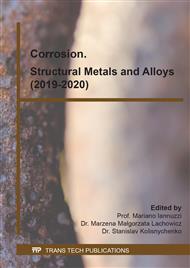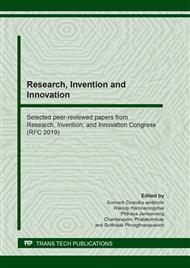[1]
S. Chandra-ambhorn, P. Saranyachot, T. Thublaor, High temperature oxidation behaviour of Fe-15.7 wt.% Cr-8.5 wt.% Mn in oxygen without and with water vapour at 700 ºC, Corros. Sci. 148 (2019) 39-47.
DOI: 10.1016/j.corsci.2018.11.023
Google Scholar
[2]
V. Parry, W. Wongpromrat, L. Latu-Romain, C. Pascal, W. Chandra-ambhorn, S. Chandra ambhorn, Y. Wouters, A. Galerie, Morpho-chemical investigations and thermodynamic study of Nb-rich passive nodules grown on AISI 441 oxidized in wet atmosphere, Corros. Sci. 141 (2018) 255-263.
DOI: 10.1016/j.corsci.2018.06.036
Google Scholar
[3]
S. Chandra-ambhorn, P. Saranyachot, Effect of the H2 content in shielding gas on the microstructure and oxidation resistance of Fe-15.7 wt.% Cr-8.5 wt.% Mn steel GTA welds, J. Mater. Process. Technol. 268 (2019) 18-24.
DOI: 10.1016/j.jmatprotec.2019.01.004
Google Scholar
[4]
Z. Ahmad (Ed.), High Temperature Corrosion, InTech, (2016).
Google Scholar
[5]
Z.-P. Wang, L. Zhang, J. Liu, Y.-F. Zhao, B. Geng, D.-H. Wang, Failure analysis of high temperature steam oxidation of T22 and T91 tubes for power station, (2004).
Google Scholar
[6]
W. Wongpromrat, V. Parry, F. Charlot, A. Crisci, L. Latu-Romain, W. Chandra-ambhorn, S. Chandra-ambhorn, A. Galerie, Y. Wouters, Possible connection between nodule development and presence of niobium and/or titanium during short time thermal oxidation of AISI 441 stainless steel in wet atmosphere, Mater. High. Temp. 32 (2015) 22-27.
DOI: 10.1179/0960340914z.00000000057
Google Scholar
[7]
W. Wongpromrat, G. Berthomé, V. Parry, S. Chandra-ambhorn, W. Chandra-ambhorn, C. Pascal, A. Galerie, Y. Wouters, Reduction of chromium volatilisation from stainless steel interconnector of solid oxide electrochemical devices by controlled preoxidation, Corros. Sci. 106 (2016) 172-178.
DOI: 10.1016/j.corsci.2016.02.002
Google Scholar
[8]
S. Chandra-ambhorn, Y. Wouters, L. Antoni, F. Toscan, A. Galerie, Adhesion of oxide scales grown on ferritic stainless steels in solid oxide fuel cells temperature and atmosphere conditions, J. Power Sources 171 (2007) 688-695.
DOI: 10.1016/j.jpowsour.2007.06.058
Google Scholar
[9]
U. Krupp, V.B. Trindade, P. Schmidt, H.-J. Christ, U. Buschmann, W. Wiechert, Oxidation mechanisms of Cr-containing steels and Ni-base alloys at high temperatures Part II: Computer-based simulation, Mater. Corros. 57 (2006) 263-268.
DOI: 10.1002/maco.200503933
Google Scholar
[10]
J. Rufner, P. Gannon, P. White, M. Deibert, S. Teintze, R. Smith, H. Chen, Oxidation behavior of stainless steel 430 and 441 at 800°C in single (air/air) and dual atmosphere (air/hydrogen) exposures, Int. J. Hydrogen Energ. 33 (2008) 1392-1398.
DOI: 10.1016/j.ijhydene.2007.12.067
Google Scholar
[11]
G.Y. Lai, High-temperature corrosion and materials applications, ASM International, Materials Park, 2008, c2007.
Google Scholar
[12]
A.J. Sedriks, Corrosion of stainless steels, 2nd ed., Wiley-Interscience, New York, N.Y., (1996).
Google Scholar
[13]
H.S. Khatak, B. Raj, Corrosion of austenitic stainless steel ;: Mechanism, mitigation and monitoring, Woodhead Publishing Ltd, Cambridge, (2002).
Google Scholar
[14]
S. Chandra-ambhorn, T. Thublaor, C. Pascal, CHAPTER 1 Thermodynamics and Kinetics of the High Temperature Oxidation of Stainless Steels, SSP 300 (2020) 1-24.
DOI: 10.4028/www.scientific.net/ssp.300.1
Google Scholar
[15]
D. Chakraborty, S. Ranganathan, S.N. Sinha, Investigations on the carbothermic reduction of chromite ores, Metall. Mater. Trans. B 36 (2005) 437-444.
DOI: 10.1007/s11663-005-0034-z
Google Scholar
[16]
T. Mori, J. Yang, M. Kuwabara, Mechanism of Carbothermic Reduction of Chromium Oxide, ISIJ Int. 47 (2007) 1387-1393.
DOI: 10.2355/isijinternational.47.1387
Google Scholar
[17]
F. Apaydin, A. Atasoy, K. Yildiz, Effect of mechanical activation on carbothermal reduction of chromite with graphite, Can. Metall. Q. 50 (2011) 113-118.
DOI: 10.1179/000844311x12949291728014
Google Scholar
[18]
Y.-l. Zhang, W.-m. Guo, Y. Liu, X.-l. Jia, Reduction mechanism of Fe2O3-Cr2O3-NiO system by carbon, J. Cent. South Univ. 23 (2016) 1318-1325.
DOI: 10.1007/s11771-016-3182-1
Google Scholar
[19]
C. Takano, A.P. Zambrano, A.E.A. Nogueira, M.B. Mourao, Y. Iguchi, Chromites Reduction Reaction Mechanisms in Carbon-Chromites Composite Agglomerates at 1773 K, ISIJ Int. 47 (2007) 1585-1589.
DOI: 10.2355/isijinternational.47.1585
Google Scholar
[20]
E. Shibata, S. Egawa, T. Nakamura, Reduction Behavior of Chromium Oxide in Molten Slag Using Aluminum, Ferrosilicon and Graphite, ISIJ Int. 42 (2002) 609-613.
DOI: 10.2355/isijinternational.42.609
Google Scholar
[21]
Romie D. Laranjo, Thermodynamic Analysis in the Production of Chromiun Carbide from the Reduction of Chromium Oxide with Methane-containing Gas, Int. J. Eng. Technol. 4 (2018) 227-232.
Google Scholar
[22]
O. Kubaschewski, C.B. Alcock, Metallurgical thermochemistry, 5th ed., Pergamon, Oxford, (1979).
Google Scholar



